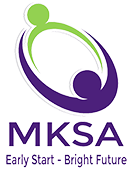What is Autism Spectrum Disorder (ASD)?
Autism and autism spectrum disorder (ASD) are terms for a group of complex neurological disorders. In 2013, with the publication of the DSM-5 all autism disorders were merged into one overall diagnosis of ASD.
Autism spectrum disorder (ASD) is characterized by social interaction difficulties, communication challenges and a tendency to engage in repetitive behaviors. However, symptoms and their severity vary widely across these three core areas. It may result in relatively mild challenges for someone on the high functioning end of the autism spectrum. For others, symptoms may be more severe, when repetitive behaviors and lack of spoken language interfere with everyday life. The basic symptoms of autism can be accompanied by other medical conditions and challenges, which can also vary widely in severity. Although it is best to begin intervention as soon as possible, the benefits of therapy can continue throughout life. Research shows the most effective treatment for children with ASD is Applied Behavior Analysis (ABA).
Indicators of ASD
ASDs are often diagnosed between the ages of 18 months and 3 years. Studies indicate that autism is four times more common in boys than girls, and there is a higher risk if a sibling is diagnosed with autism.
An evaluation for an Autism Spectrum Disorder should be considered if your child aged 14-15 months and older is demonstrating some of the following indicators of ASD:
– Rarely looks you in the eye for more than a second or two, or seems to be avoiding eye contact
– Doesn’t babble/make meaningful gestures by 1 year
– Does not speak one word by 16 months
– Does not combine two words by 2 years
– Does not respond to name when called
– Loses language or social skills
– Doesn’t play with toys appropriately
– Excessively lines up toys or objects
– No pointing to indicate what he wants or to show you an object of interest
– Does not imitate what others do (clapping, “so big”, blowing kisses, etc.)
– Lack of social-emotional reciprocity (i.e. limited or no back-and-forth conversation, reduced sharing of interests/emotions, failure to initiate and respond to social interactions)
– Abnormal body language; lack of understanding and use of gestures; lack of facial expressions and nonverbal communication
– Difficulty in developing, maintaining and understanding relationships; absence of interest in peers
– Repetitive motor movement or use of objects (hand flapping, repetitive jumping, spinning objects, lining up objects, repeatedly throwing toys to floor)
– Repeatedly vocalizes parts of TV shows, books, or previously heard conversations (this could be immediately after hearing them or days later)
– Insistence on sameness, inflexible adherence to routines (i.e. difficulties with transitions, need to take same route or eat same food every day)
As with any concerns, speak with your pediatrician first. MKSA is always available to answer questions and make appropriate referrals. For more information, call (516) 731-5588 or contact us by email.
Some information courtesy of autismcenter.org, National Institute of Mental Health, and DSM-5 checklist
ABA Services
Applied Behavior Analysis (ABA) is considered the treatment of choice for autism spectrum disorder (ASD).
MKSA continues to be a leader in the area of bringing standardized testing and ABA services to early intervention. Our agency has some of the area’s most experienced and respected diagnosticians. Experts at ruling out ASD, they use the most current testing procedures, informal observation and clinical judgment, and take the time to make sure they have a complete picture of your child.
Applied Behavior Analysis (ABA) focuses on the principles that explain how learning takes place. Positive reinforcement is one such principle. When a behavior is followed by some sort of reward, the behavior is more likely to be repeated. Through decades of research, the field of behavior analysis has developed many techniques for increasing useful behaviors and reducing those that may cause harm or interfere with learning. ABA is the use of these techniques and principles to bring about meaningful and positive changes in behavior. ABA therapy sessions often involve one-on-one interaction between the ABA provider and the child. These techniques can be used in structured situations such as the classroom as well as in everyday situations.
Our ABA Teachers
Our ABA staff are Board Certified Behavior Analysts (BCBA) or Board Certified Associate Behavior Analysts (BCaBA). Our ABA team leaders are all experienced special education teachers with years of education, training, and practical experiences in developing programs and working with children and their families. Our ABA providers are all certified special education teachers who have fulfilled the necessary criteria for effective teaching on an ABA team. These requirements include coursework and supervised hands-on training in the field. This expertise is combined with a genuine concern for families and an understanding of the challenges they face and the benefits they can enjoy from these services. Our providers love their work, care about what they do and are dedicated in their efforts to work with every child as an individual.

